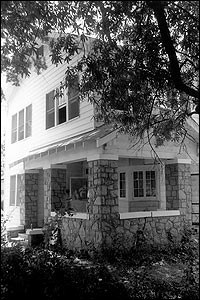Listed in Arkansas Register of Historic Places on 12/02/98
SUMMARY
A large Craftsman-style residence, the Bruce House is situated on two lots at the north end of the 1100 block of Pulaski Street. The two-story, frame structure has many excellent Craftsman features, including a nicely detailed porch with granite columns. However, the Bruce House is not a typical example of the Craftsman style, perhaps because it was built around the remnants of an earlier house that is thought to have burned.
Dr. Warren J. E. Bruce, one of Little Rock’s first African-American physicians, lived at 1102 Pulaski Street from the late 1890s until about 1926. The home’s association with him, along with the type of work he oversaw during his tenure in the house, are the basis for its significance.
The house that originally stood at 1102 Pulaski Street was built about 1885 for Henry K. Pittmore, who at the time was editor of the Mosaic Guide, official publication of the Mosaic Templars of America, a black fraternal organization founded in Little Rock in 1882. Pittmore sold the house about 1889 to F. B. T. Hollenberg, a white businessman, who maintained it as rental property. Dr. Warren J. E. Bruce moved into the house in the late 1890s, apparently renting it from Hollenberg for several years before purchasing it.
Biographical information about Dr. Bruce unfortunately is sparse, but it is known that he was among a handful of African-American physicians who practiced in Little Rock before 1900. A graduate of Meharry Medical College in Nashville, Tennessee, he initially located in Wrightsville, Arkansas, before moving to Little Rock in 1891. Dr. Bruce’s name first appears in the Little Rock city directory for 1893-94, when he is listed as one of two black physicians in the city. His office was in the black business district on West 9th Street.
About 1915, several years after Dr. Bruce bought 1102 Pulaski from F. B. T. Hollenberg, the house is thought to have been extensively damaged by fire. In Pulaski County real estate records, the assessed value of the improvements to Dr. Bruce’s property dropped from $1,000 in 1915 to $350 in 1916, an indication of major damage to the house. Charred wood found in the house indicates that the damage was caused by fire.
Like other cost-conscious residents of the Dunbar neighborhood, Dr. Bruce evidently did not level his old home and rebuild entirely from scratch. Rather, it appears that he worked around the original floorplan, incorporating undamaged sections into his new residence. A three-sided bay at the front of the house and an Italianate-style staircase are conspicuous leftovers from the original 1880s structure, as are many two-over-two, double-hung windows. Even so, the "new" Bruce House-rebuilt during 1916-boasted a fashionable Craftsman-style exterior with an especially well-detailed front porch.
Dr. Bruce remained at 1102 Pulaski until about 1926, and the house subsequently has had four owners, including one who put it to use as a rooming house during the 1930s and 1940s. The current owner, who bought the property earlier this year, would like to return the house to its appearance during Dr. Bruce’s tenure.
Although it has been altered, the Bruce House’s association with one of Little Rock’s first African-American physicians makes it an important representative of the city’s black heritage. In addition, the work that Dr. Bruce oversaw after the original residence was damaged by fire illustrates a common theme in the history of the Dunbar neighborhood’s development: the tendency of even the more prosperous black residents to stay in one location and remodel their homes, often incorporating pieces salvaged from older structures.
BIBLIOGRAPHY
Insurance Maps of Little Rock, Arkansas. Vol. II. New York: Sanborn Map Co., 1939.
Insurance Maps of Little Rock, including Argenta and Pulaski Heights, Arkansas. Vol. I. New York: Sanborn Map Co., 1913.
Insurance Maps of Little Rock, North Little Rock, and Baring Cross, Arkansas. New York: Sanborn-Perris Map Company, 1897.
Little Rock, Arkansas. Department of Housing and Neighborhood Programs.
Constance E. Sarto and Sandra Taylor Smith, "Little Rock’s ‘Center City’ Neighborhood," December 1993.
Little Rock City Directories: 1886 through 1975.
Little Rock, Arkansas. Arkansas History Commission. Pulaski County Real
Estate Assessment Records, 1883-84 through 1929.
Work Projects Administration Writers’ Program. Survey of Negroes In Little Rock and North Little Rock. Little Rock: Urban League of Greater Little Rock, Arkansas, 1941.
